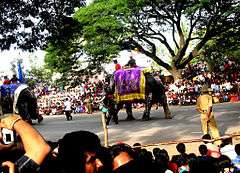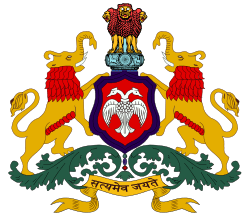Mysore Dasara
| Mysore Dasara | |
|---|---|
 Mysore Dasara procession | |
| Also called | Jamboo Savāri |
| Type | Cultural, Religious (Hindu) |
| Significance | Marking the victory of good over evil |
| Celebrations | lighting Mysuru Palace, Ramayana theatre, mela (fairs), processions and parades |
| Begins | September/October per Hindu calendar |
| Ends | 10 days later |
| Frequency | Annual |
| First time | October 1610 |
| Related to | Devi (goddess Shakti), The Ramayana, the Vijayanagara Empire, the Kingdom of Mysore, the Wadiyar Dynasty |
Mysuru Dasara (Kannada: ದಸರಾ ಹಬ್ಬ) is the Nadahabba (state-festival) of the state of Karnataka in India. It is a 10-day festival, starting with Navaratri (Nava-ratri means nine-nights) and the last day being Vijayadashami. The festival is observed on the tenth day in the Hindu calendar month of Ashvin, which typically falls in the Gregorian months of September and October.[1][2][3]
The Hindu festival of Dasara, Navratri and Vijayadashami celebrates the victory of good over evil. It was the day in the Hindu legends when Goddess Chamundeshwari (Durga) killed the demon Mahishasura.[4] Mahishasura is the demon whose slaying by the Goddess gave the city the name Mysuru. The Mysuru tradition celebrates the warriors and the state fighting for the good during this festival, ritually worshipping and displaying the state sword, weapons, elephants, horses along with Hindu Devi goddess in her warrior form (predominantly) as well as the Vishnu avatar Rama. The ceremonies and a major procession is traditionally presided by the king of Mysuru.[4]
The city of Mysuru has a long tradition of celebrating the Dasara festival with grandeur and pomp to mark the festival. The Dasara festival in Mysuru completed 400th anniversary in year 2010,[5] while evidence suggests the festivities were observed in Karnataka state by the Vijayanagara Empire kings in the 15th century.[6]
History
The Dasara festivities began with the Vijayanagar kings as early as the 15th Century.[7] The festival played a historical role in the 14th-century Vijayanagara Empire, where it was called Mahanavami and the festivities are shown in the relief artwork of the outer wall of the Hazara Rama temple of Hampi.[8][9]
The Italian traveller Niccolò de' Conti described the festival's intensity and importance as a grandeur religious and martial event with royal support. The event revered Durga as the warrior goddess (some texts refer to her as Chamundeshwari). The celebrations hosted athletic competitions, singing and dancing, fireworks, a pageantry military parade and charitable giving to the public.[10][11]
After the fall of the Vijayanagar to Deccan Sultanates, these Hindu celebrations came to an end under Muslim rulers. The Wodeyars of Mysore formed a kingdom in Southern parts of the Vijayanagara Empire and continued the Mahanavami (Dasara) festival celebration, a tradition started initially by Raja Wodeyar I (1578-1617 CE) in the year 1610 at Srirangapatna.[12][13]
Festivities

| Part of a series on the |
| Culture of Karnataka |
|---|
 |
Vijayanagara: |
Dialects: (Bangalore Kannada. Bangalori Urdu. Mangalore Kannada) |
|
Mythology and folklore |
|
Festivals
|
|
Art
|
|
Music and performing arts
|
|
|
Monuments
|
|
Symbols |
|
Organisations
|
|
The festivities included a special durbar (royal assembly). It was during the reign of Krishnaraja Wodeyar III in the year 1805, when the king started the tradition of having a special durbar in the Mysore Palace during Dasara; which was attended by members of the royal family, special invitees, officials and the masses. After the death of Srikanta Wadiyar in December 2013, this tradition has been continued by placing the "Pattada Katti" (royal sword) on the golden throne.[14][15][16] The ninth day of Dasara called as Mahanavami is also an auspicious day on which the royal sword is worshipped and is taken on a procession involving elephants, camels and horses.[17]
Lighting at Mysore Palace
The main attraction of the ten-day Mysore Dasara festival is the Mysore Palace which is illuminated daily with nearly 100,000 light bulbs from 7 pm to 10 pm on all days of the festival.[18] Various cultural and religious programs highlighting the dance, music and culture of the State of Karnataka are performed in front of the illuminated Palace.[19]
Procession
On Vijayadashami, the traditional Dasara procession (locally known as Jumboo Savari) is held on the streets of Mysore city. The main attraction of this procession is the idol of the Goddess Chamundeshwari which is placed on a golden mantapa (which is around 750 kilograms of gold) on the top of a decorated elephant. This idol is worshipped by the royal couple and other invitees before it is taken around in the procession. Colourful tableaux, dance groups, music bands, decorated elephants, horses and camels form a part of the procession which starts from the Mysore Palace and culminates at a place called Bannimantap where the banni tree (Prosopis spicigera) is worshipped. According to a legend of the Mahabharata, banni tree was used by the Pandavas to hide their weapons during their one-year period of Agnatavasa (living life incognito). Before undertaking any warfare, the kings traditionally worshipped this tree to help them emerge victorious in the war.[17] The Dasara festivities would culminate on the night of Vijayadashami with an event held in the grounds at Bannimantap called as Panjina Kavayatthu (torch-light parade).
In Mysore, India, the Vijayadashami Elephant procession during Mysore Dasara is called Jumbo Savari (from the British during their control of Mysore State). The original name to this procession is Jumbi Savari ("going to the Shami (Banni) tree"). Now Goddess Chamundeshwari is taken in procession on an Elephant. But the "Jumbo" name is still intact.
After the Jamboo Savari, a torchlight parade takes place in the evening at the Bannimantap Parade Grounds.
Exhibition
Another major attraction during Dasara is the Dasara exhibition which is held in the exhibition grounds opposite to the Mysore Palace. The exhibition was started by the Maharaja of Mysore Chamaraja Wodeyar X in 1880 with the sole aim of introducing timely developments to the people of Mysore. The task of holding the exhibition is now entrusted with the Karnataka Exhibition Authority (KEA).[20] This exhibition starts during Dasara and goes on till December. Various stalls which sell items like clothes, plastic items, kitchenware, cosmetics and eatables are set up and they attract a significant number of people. A play area containing attractions like a Ferris wheel is also present to provide entertainment to the people. Various Governmental agencies setup stalls to signify the achievements and projects that they have undertaken.
Other programmes
On all the 10 days of Dasara, various music and dance concerts are held in auditoriums around Mysore city. Musicians and dance groups from all over India are invited to perform on this occasion. Another attraction during Dasara is the Kusti Spardhe (wrestling-bout) which attracts wrestlers from all around India.
See also
- Arjuna, the lead elephant of the Mysore Dasara procession
- Dasara (disambiguation) — uses of the term in other Indian states
- Dasara Elephants
- Mysore Dasara 2013
References
- ↑ Encyclopedia Britannica 2015.
- ↑ James G. Lochtefeld 2002, pp. 212-213, 468-469.
- ↑ Encyclopedia Britannica Dussehra 2015.
- 1 2 Christopher John Fuller (2004). The Camphor Flame: Popular Hinduism and Society in India. Princeton University Press. pp. 114–126. ISBN 0-691-12048-X.
- ↑ "400th Mysore Dasara begins today". The Times Of India. 2010-10-07.
- ↑ Dasara of Mysore, All India Radio, Government of India
- ↑ "WebHost4Life - Web Hosting, Unix Hosting, E-Mail, Web Design". www.ourkarnataka.com. Retrieved 2 April 2018.
- ↑ John M. Fritz; George Michell; John Gollings (2003). Hampi. India Book House. pp. 46–47, 87–90.
- ↑ P. J. Marshall (2005). The Eighteenth Century in Indian History: Evolution Or Revolution?. Oxford University Press. pp. 285 note 3. ISBN 978-0-19-567814-7.
- ↑ Christopher John Fuller (2004). The Camphor Flame: Popular Hinduism and Society in India. Princeton University Press. pp. 117–119. ISBN 978-0-69112-04-85.
- ↑ S Sivapriyananda (1995). Mysore Royal Dasara. Abhinav Publications. pp. 73–75.
- ↑ Christopher John Fuller (2004). The Camphor Flame: Popular Hinduism and Society in India. Princeton University Press. pp. 114–115. ISBN 0-691-12048-X.
- ↑ P. J. Marshall (2005). The Eighteenth Century in Indian History: Evolution Or Revolution?. Oxford University Press. pp. 268–270. ISBN 978-0-19-567814-7.
- ↑ R. Krishna Kumar. "Emotional start to private Dasara". The Hindu. Retrieved 22 October 2015.
- ↑ "With no scion, the sword ‘rules’ at the Mysore Palace". deccanchronicle.com. 26 September 2014. Retrieved 2 April 2018.
- ↑ "Royal Sword takes king's place at Khas Durbar". Deccan Herald. Retrieved 22 October 2015.
- 1 2 Detailed account of the Mysore Dasara festival is provided by Prabuddha Bharata. "Mysore Dasara - A Living Tradition". Webpage of eSamskriti.com. Shri Sanjeev Nayyar. Archived from the original on 2007-03-07. Retrieved 2007-04-04.
- ↑ "Mysore Dasara, Nadahabba, Mysore Royal Festival, Karnataka State Festival". mysoredasara.org. Retrieved 22 October 2015.
- ↑ "Mysore Dasara". inMysore.com. Retrieved 22 October 2015.
- ↑ "All roads lead to the expo". Deccan Herald. Retrieved 23 November 2010.
Bibliography
- Amazzone, Laura (2012). Goddess Durga and Sacred Female Power. University Press of America. Retrieved 5 February 2017.
- Coburn, Thomas B. (1991). Encountering the Goddess: A translation of the Devi-Mahatmya and a Study of Its Interpretation. State University of New York Press. ISBN 0791404463.
- Paul Reid-Bowen (2012). Denise Cush; Catherine Robinson; Michael York, eds. Encyclopedia of Hinduism. Routledge. ISBN 978-1-135-18979-2.
- Constance Jones; James D. Ryan (2006). Encyclopedia of Hinduism. Infobase Publishing. ISBN 978-0-8160-7564-5.
- David Kinsley (1988). Hindu Goddesses: Visions of the Divine Feminine in the Hindu Religious Tradition. University of California Press. ISBN 978-0-520-90883-3.
- James G. Lochtefeld (2002). The Illustrated Encyclopedia of Hinduism: N-Z. The Rosen Publishing Group. ISBN 0-8239-2287-1.
- June McDaniel (2004). Offering Flowers, Feeding Skulls: Popular Goddess Worship in West Bengal. Oxford University Press. ISBN 978-0-19-534713-5.
- Rachel Fell McDermott (2001). Mother of My Heart, Daughter of My Dreams: Kali and Uma in the Devotional Poetry of Bengal. Oxford University Press. ISBN 978-0-19-803071-3.
- Rocher, Ludo (1986). The Puranas. Otto Harrassowitz Verlag. ISBN 978-3447025225.
- Hillary Rodrigues (2003). Ritual Worship of the Great Goddess: The Liturgy of the Durga Puja with Interpretations. SUNY Press. ISBN 978-0-7914-8844-7.
- "Navratri – Hindu festival". Encyclopedia Britannica. 2017. Retrieved 2017-02-21.
- "Dussehra – Hindu festival". Encyclopedia Britannica. 2014. Retrieved 2017-02-21.
External links
| Wikimedia Commons has media related to Mysore Dasara. |
.jpg)
